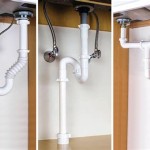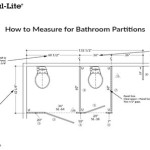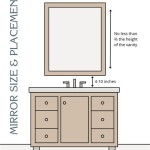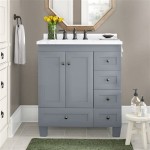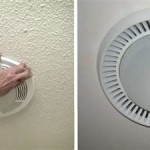How To Replace A P-Trap In The Bathroom
The P-trap, a ubiquitous plumbing component beneath bathroom sinks, plays a crucial role in maintaining sanitation and preventing noxious sewer gases from entering the living space. It functions by trapping a small amount of water, creating a seal that blocks the upward flow of these gases. Over time, P-traps can corrode, crack, or become clogged, necessitating replacement. This article provides a comprehensive guide on how to replace a P-trap in a bathroom, covering essential tools, step-by-step instructions, and important considerations for a successful installation.
Before initiating the replacement process, it is paramount to understand the P-trap's function and identify the type of replacement needed. P-traps are generally constructed from either PVC plastic or metal, such as chrome-plated brass. Plastic P-traps are typically easier to install and more resistant to corrosion, while metal P-traps offer greater durability and aesthetic appeal. Selecting the correct replacement trap involves matching the material, diameter, and configuration of the existing trap. In some cases, a universal P-trap kit can be employed, offering a range of fittings to accommodate various pipe sizes and orientations.
Prior to commencing any plumbing work, safety precautions are essential. Wear appropriate eye protection, such as safety glasses or goggles, to shield the eyes from debris and potential splashes. It is also advisable to wear gloves to protect the hands from contaminants and sharp edges. Ensure adequate ventilation in the bathroom by opening windows or using an exhaust fan. Turn off the water supply to the sink by closing the shut-off valves located beneath the sink. If shut-off valves are not present or are malfunctioning, the main water supply to the house may need to be turned off, which could affect other plumbing fixtures.
Key Point 1: Preparation and Tool Acquisition
Successful P-trap replacement hinges significantly on proper preparation and the availability of the right tools. Gathering all the necessary tools before beginning the project minimizes interruptions and ensures a smoother workflow.
The essential tools and materials required include:
*New P-trap kit: Acquire a P-trap kit that matches the material and dimensions of the existing trap. Ensure the kit includes all necessary fittings and washers.
*Adjustable wrench: An adjustable wrench is necessary for loosening and tightening slip nuts and other fittings. A pipe wrench may be required if dealing with older, corroded metal pipes.
*Channel-lock pliers: These are useful for gripping and turning larger, stubborn nuts or pipes.
*Basin wrench: This specialized wrench is designed for reaching and loosening nuts in tight spaces, particularly under the sink.
*Bucket or basin: Place a bucket or basin under the P-trap to catch any residual water when the trap is disconnected.
*Plumber's tape (Teflon tape): This is used to create a watertight seal on threaded connections.
*Utility knife or pipe cutter: A utility knife can be used to trim or deburr plastic pipes, while a pipe cutter is designed for cleanly cutting metal pipes.
*Screwdriver (optional): A screwdriver may be needed to remove any retaining clips or screws holding the P-trap in place.
*Clean rags or towels: These are useful for cleaning up spills and wiping down components.
*Penetrating oil (optional): If dealing with older, corroded metal pipes, penetrating oil can help loosen stubborn connections.
Once the water supply is shut off, test the faucet to ensure that the water flow has indeed stopped. This will prevent unexpected water release during the disassembly process.
Key Point 2: P-Trap Removal
The removal process requires careful attention to avoid damaging existing pipes or fixtures. Begin by placing the bucket or basin directly underneath the P-trap to catch any remaining water.
Follow these steps to remove the existing P-trap:
1.Loosen the slip nuts: Using an adjustable wrench or channel-lock pliers, carefully loosen the slip nuts that connect the P-trap to the tailpiece (the pipe extending down from the sink drain) and the drainpipe in the wall. Turn the nuts counterclockwise.
2.Disconnect the trap: Once the slip nuts are sufficiently loosened, gently detach the P-trap from the tailpiece and the drainpipe. Be prepared for any residual water to spill into the bucket.
3.Inspect and clean the tailpiece and drainpipe: Examine the tailpiece and drainpipe for any signs of corrosion, damage, or blockage. Clean them thoroughly with a rag to remove any debris or buildup. A wire brush can be used to remove stubborn deposits.
4.Remove old washers: Carefully remove any old washers or gaskets from the tailpiece and drainpipe connections. These washers are often brittle and may crumble during removal.
5.Evaluate the condition of the drainpipe: Look inside the drainpipe extending from the wall, check for blockage, or any sign of damage. If blockage is observed, it needs to clear before installing the new P-Trap.
If the slip nuts are excessively corroded or stuck, apply penetrating oil to the threads and allow it to soak for several minutes before attempting to loosen them. If the nuts still resist, carefully cut them off using a hacksaw or pipe cutter, being cautious not to damage the tailpiece or drainpipe.
Key Point 3: New P-Trap Installation
Installing the new P-trap requires careful alignment and tightening of connections to ensure a leak-proof seal.
Follow these steps to install the new P-trap:
1.Install new washers: Place new washers or gaskets onto the tailpiece and drainpipe connections. Ensure that the washers are properly seated and aligned.
2.Assemble the P-trap: Assemble the P-trap components according to the manufacturer's instructions. The orientation of the P-trap is crucial, as it needs to hold water to function correctly.
3.Connect the P-trap: Carefully connect the P-trap to the tailpiece and drainpipe, ensuring that the connections are aligned properly. Slide the slip nuts over the connections and hand-tighten them.
4.Tighten the slip nuts: Using an adjustable wrench or channel-lock pliers, tighten the slip nuts securely. Do not overtighten, as this can damage the plastic or metal components. A snug fit is sufficient to create a watertight seal.
5.Check the alignment: Before fully tightening the connections, check the alignment of the P-trap to ensure that it is properly positioned and not under any unnecessary strain.
6.Turn on the water supply: Slowly turn on the water supply to the sink and check for leaks at all connections. If any leaks are detected, tighten the corresponding slip nut slightly. If tightening does not resolve the leak, disassemble the connection and inspect the washer or gasket for damage or misalignment. Reassemble and tighten the connection again.
7.Test the drain: Once all connections are leak-free, run water into the sink and observe the drain flow. Ensure that the water drains smoothly and that there are no unusual noises or backups.
If the drainpipe in the wall is slightly misaligned with the tailpiece, use a flexible P-trap extension or a slip joint extension to compensate for the misalignment. These extensions provide some flexibility in the connection and can help prevent leaks.
When using plumber's tape on threaded connections, wrap the tape clockwise around the threads, overlapping each layer slightly. This creates a tighter seal and helps prevent leaks. Use only a few layers of tape, as excessive tape can actually hinder the connection.
After completing the installation, thoroughly clean the work area and dispose of all waste materials appropriately. Check the P-trap periodically for any signs of leaks or corrosion. If any issues are detected, address them promptly to prevent further damage or water damage.
In situations where the drainpipe is significantly damaged or corroded, it may be necessary to replace the entire drainpipe section. This is a more complex task that may require specialized tools and expertise. If you are not comfortable performing this type of repair, it is advisable to consult a qualified plumber.
Regular maintenance of the P-trap can help prevent clogs and extend its lifespan. Periodically flush the P-trap with hot water to remove any accumulated debris. Avoid pouring grease or oil down the drain, as these substances can solidify and cause blockages. Using a strainer in the sink drain can also help prevent hair and other debris from entering the P-trap.
When selecting a P-trap kit, consider purchasing a kit that includes a cleanout plug. This plug allows for easy access to the P-trap for cleaning and unclogging without having to disassemble the entire trap. This feature can be particularly useful in bathrooms that are prone to drain clogs.

How To Install A Bottle Trap With Pop Up Drain Stopper Replace Your Old P Upgrade

How To Install P Trap And Bathroom Sink Drain Piping Easy Installation For Beginners

Replacing Your S Trap Thebath Com

How To Install The P Trap Under A Sink Dummies

Shower P Traps What Are They Used For And How Do You Replace Them

Bathroom Renovation How To Replace A Shower P Trap

How To Install A P Trap
Reversing P Trap In Bathroom Sink Drain Diy Home Improvement Forum

How To Install A Plastic Bathroom P Trap

Replumbing An Improper Trap Home Improvement Stack Exchange Blog
Related Posts
